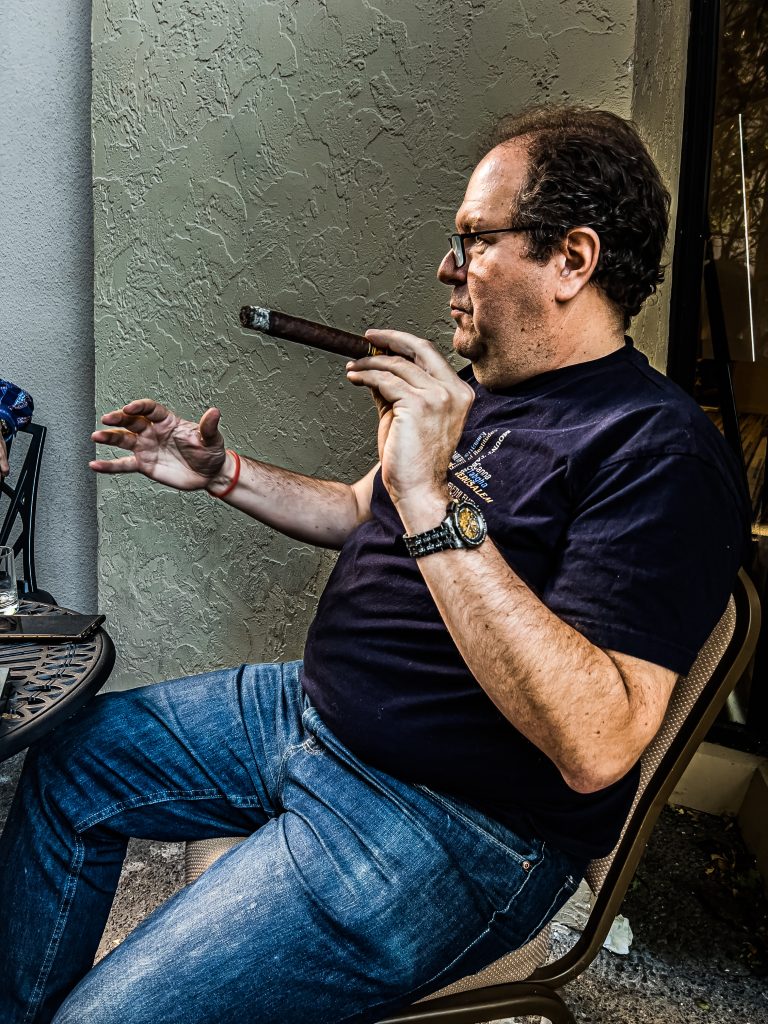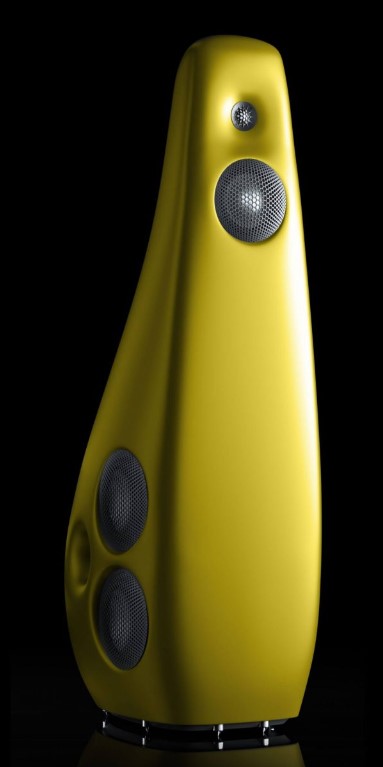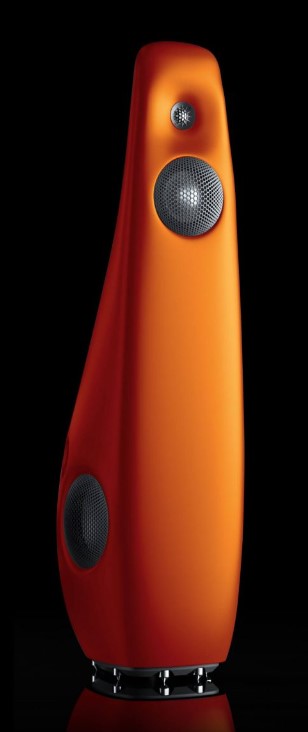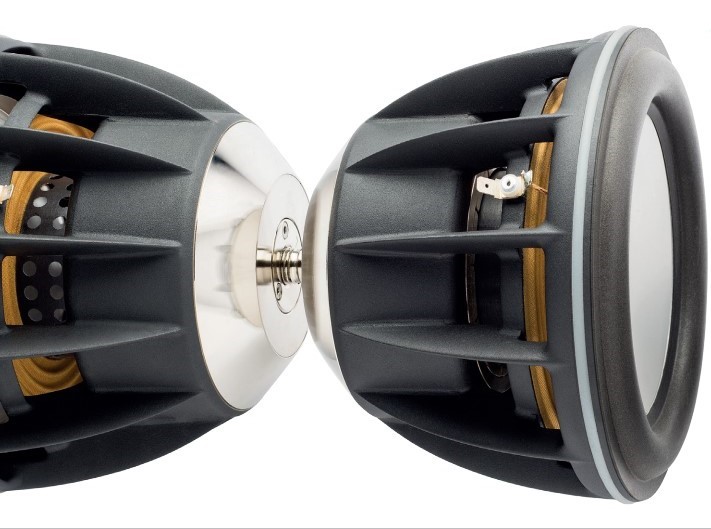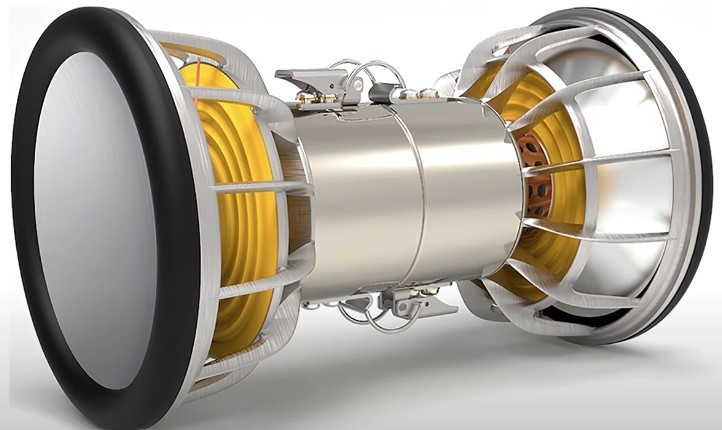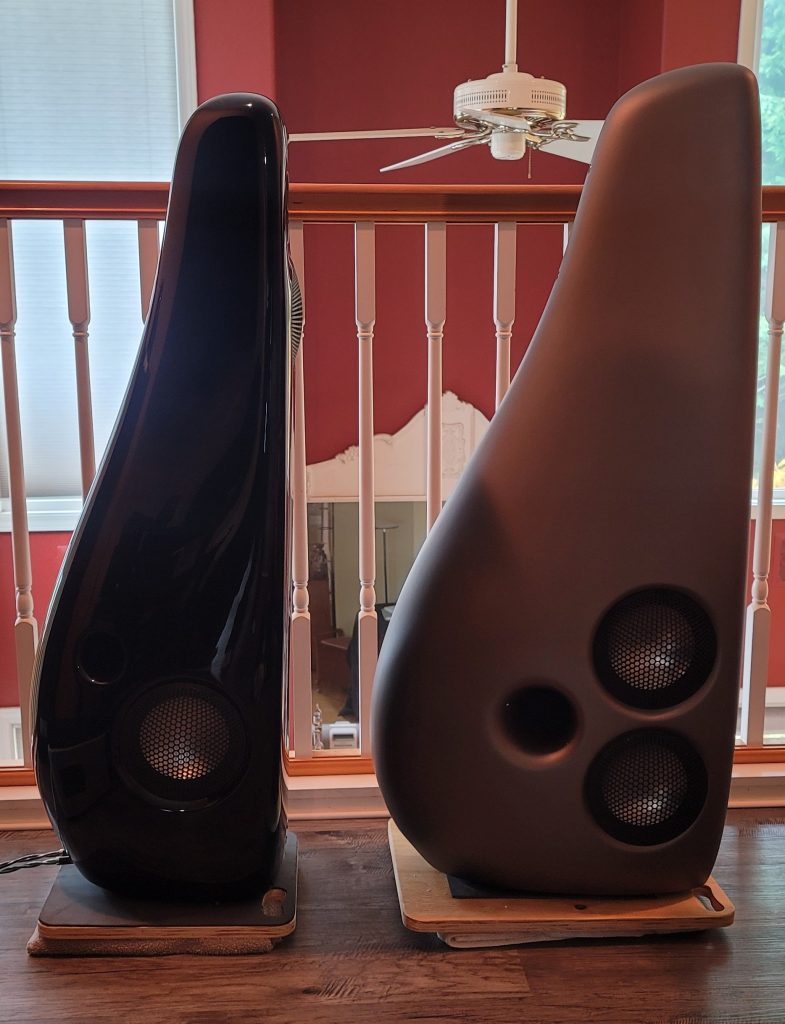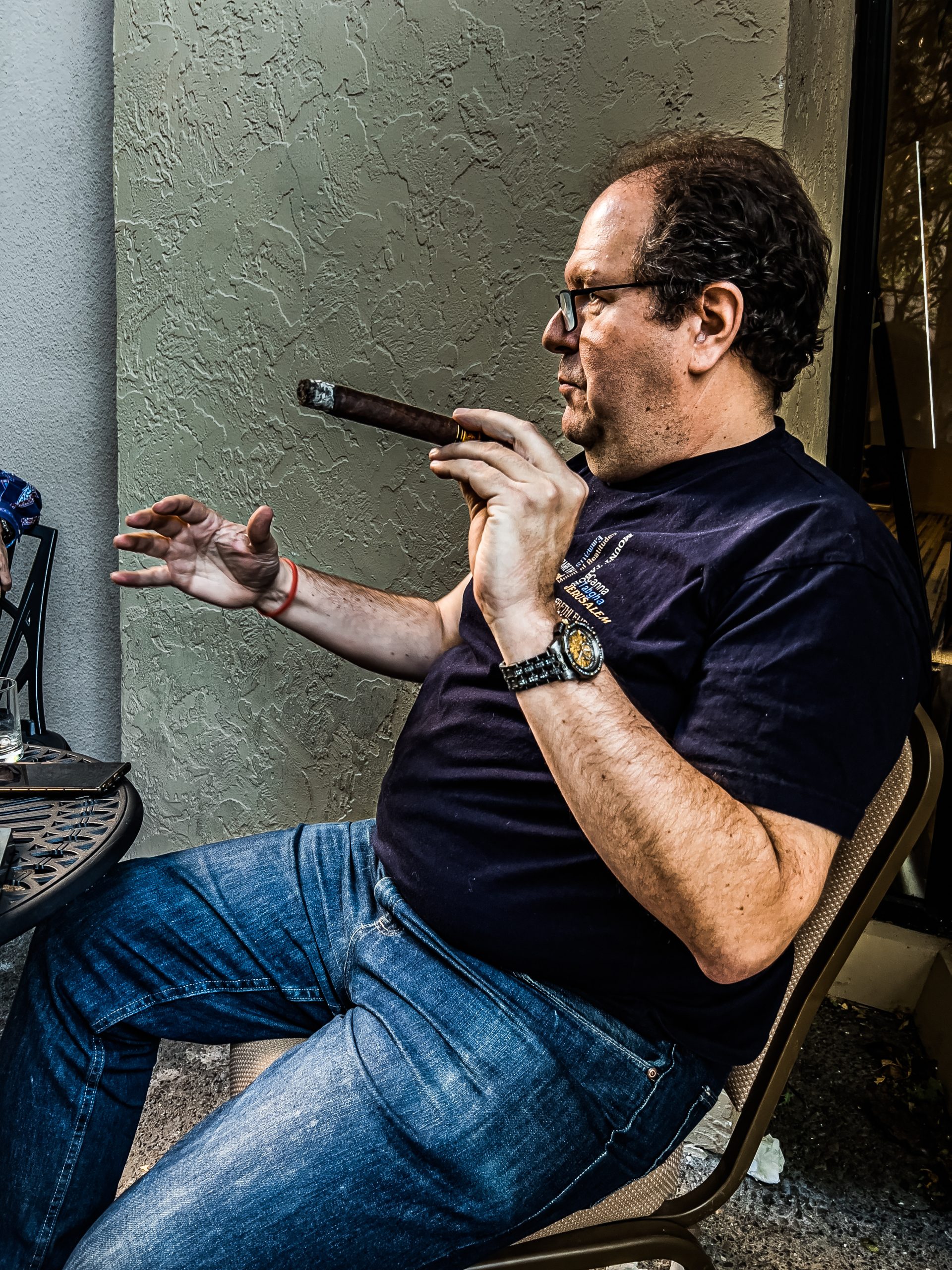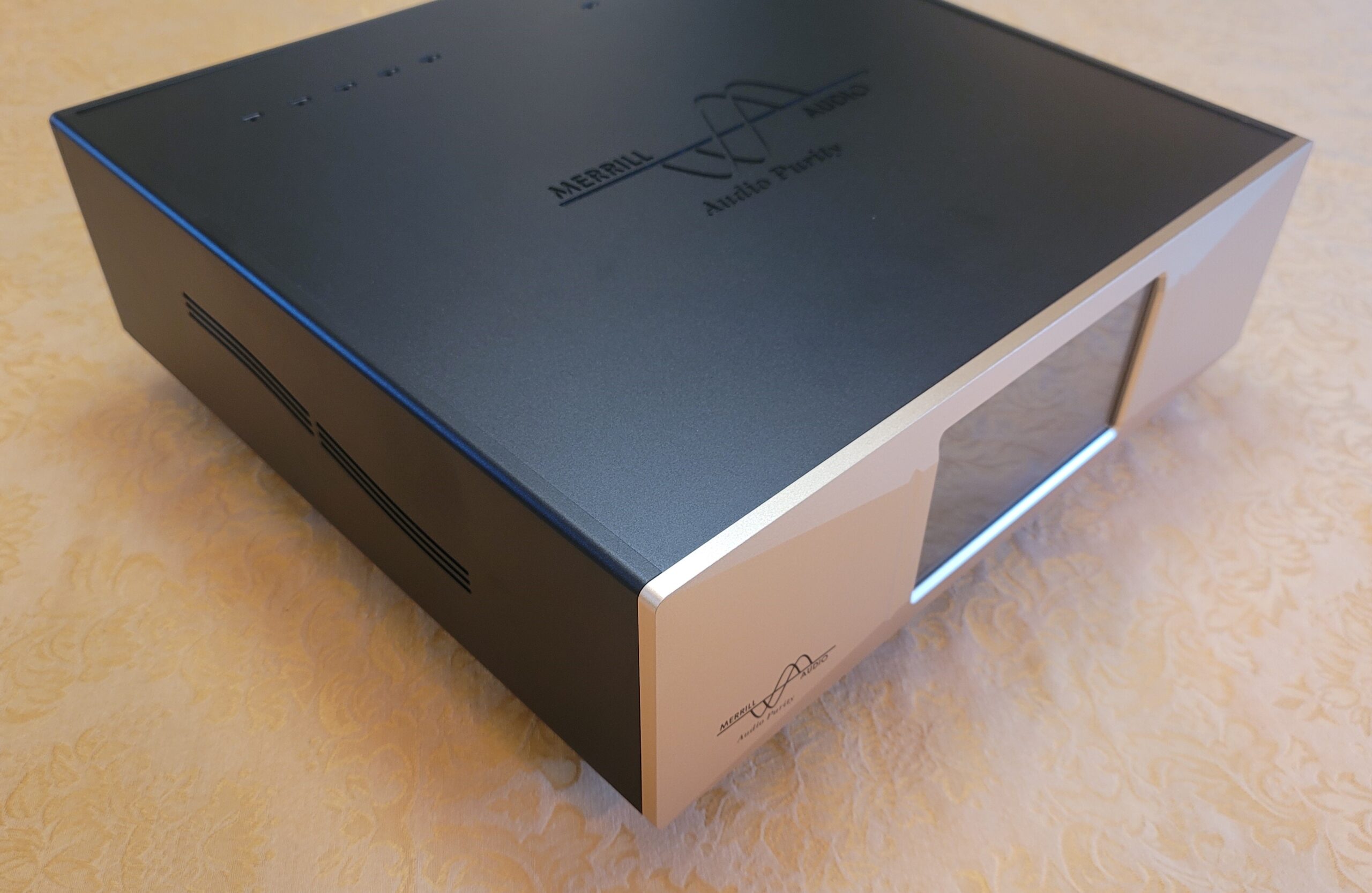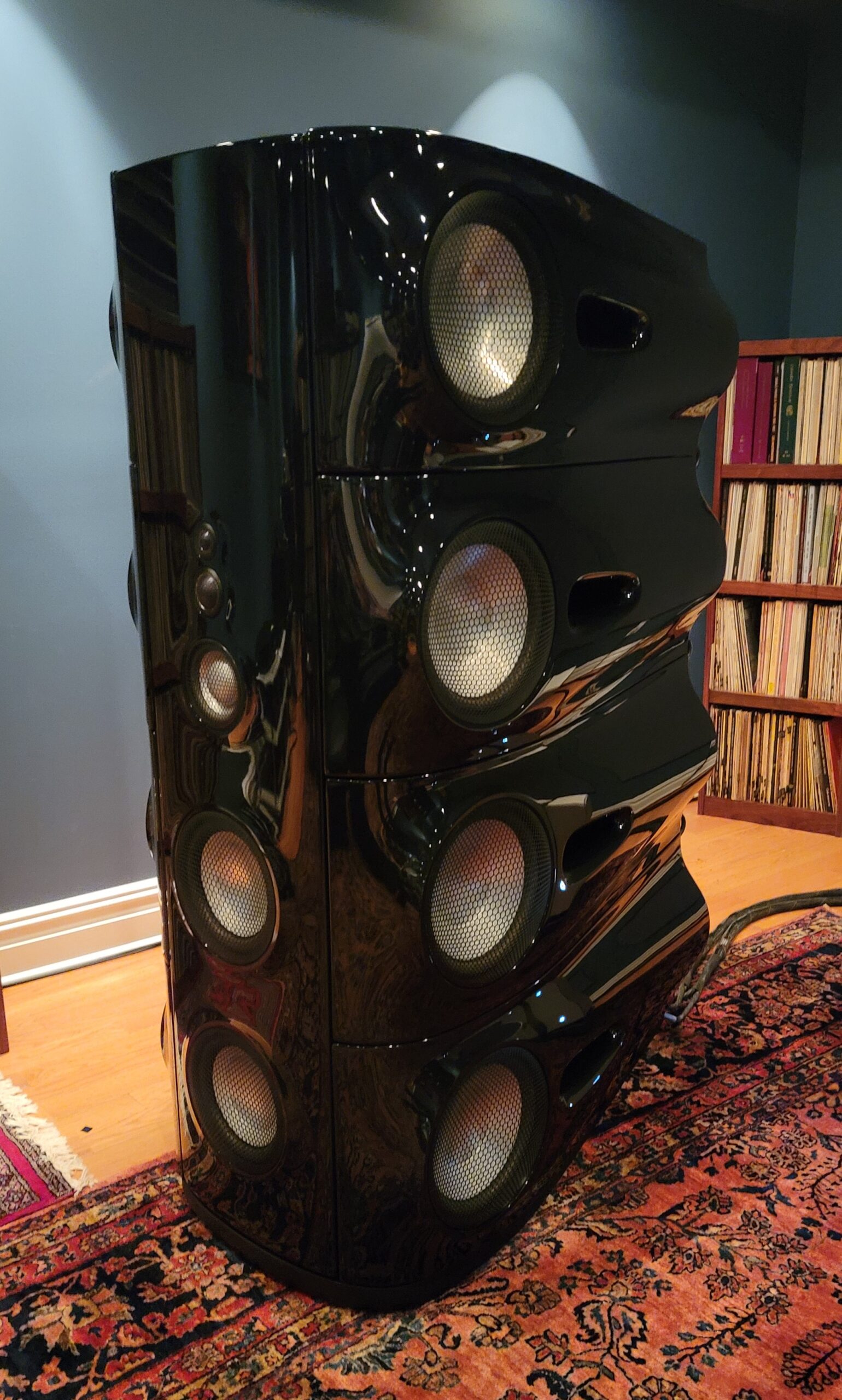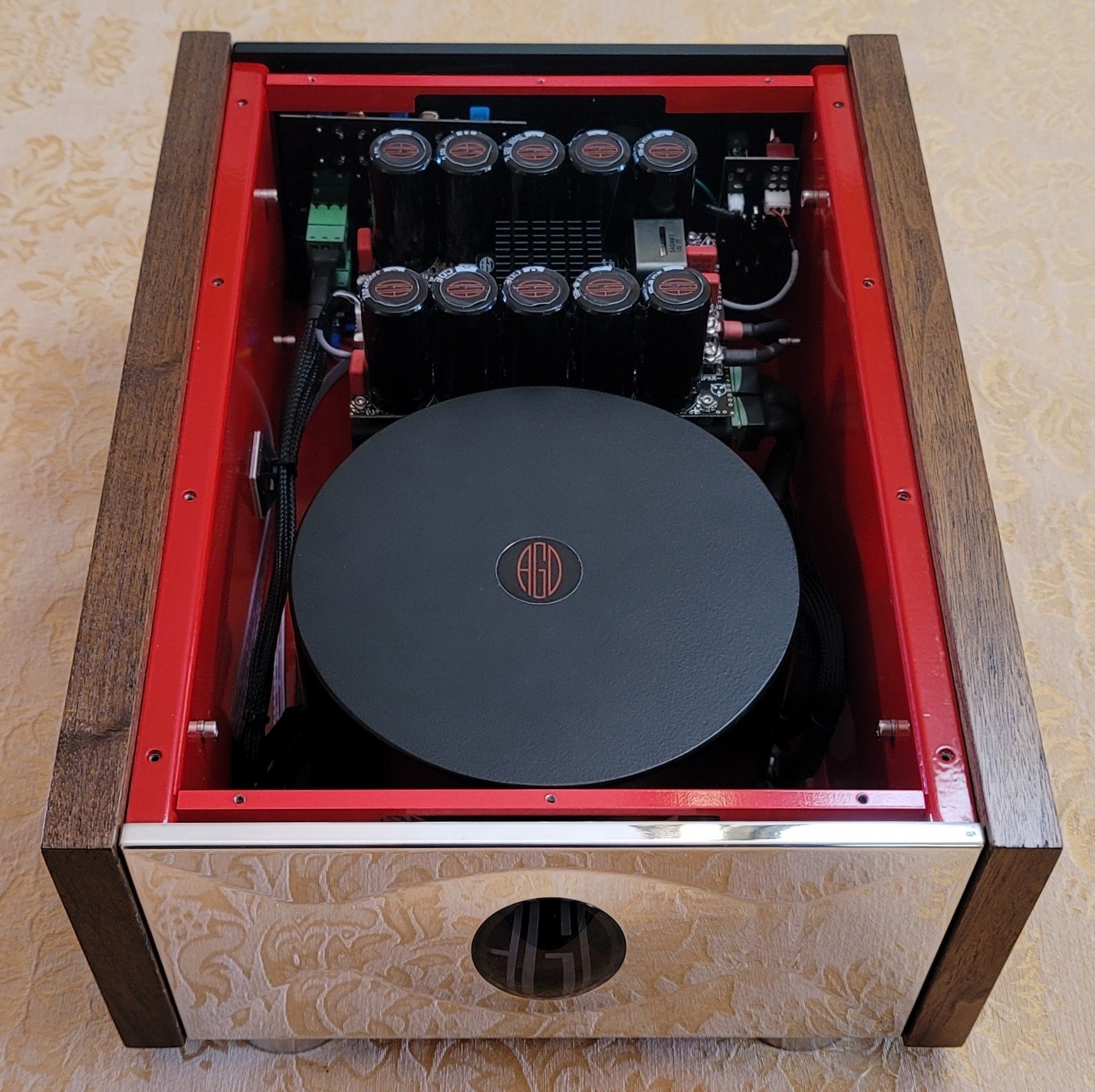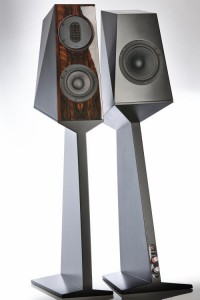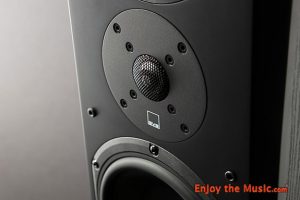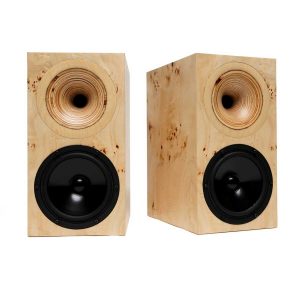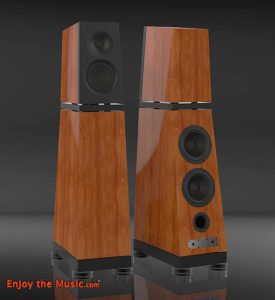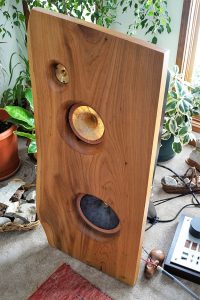Dean Waters with cigar: a portrait at Pacific Audio Fest 2023 (photograph and image processing by David W. Robinson)
The Vivid Audio Kaya 90 loudspeaker in one of its many custom colors (image courtesy of Vivid Audio)
The smaller Kaya 45, again in a custom color (image courtesy of Vivid Audio)
The Kaya product line of loudspeakers is a mid-line product range from Vivid Audio. Don't let the mid-line label be misleading, though. These speakers are brilliant!
The first thing that sets them apart is their stunning appearance. When I think of loudspeakers the first thing that comes to mind are big black boxes that aren't necessarily attractive. We've pretty much come to expect that speakers come in big rectangular cabinets that just sit on the floor, are heavy, and do their job. Usually quite plain in appearance; often rather ugly Nothing to see here. Except for their size, no one would give them a second glance, much less pay attention to them.
That is not the case with Vivid Audio speakers. The cabinets themselves are complete works of art. Except that simply being art for the sake of being art leaves out a fundamental set of design choices for these beauties. Their striking, dare I say seductive, shapes are packed full of intentional acoustic design philosophy breakthroughs. They are readily available in piano black high-gloss, an oyster grey matte finish, and a Lexus pearl white. In addition, the Kaya's can be special ordered in any custom color the heart desires: "Any PPG automotive colour" is available, according to Vivid Audio. The means that it's nearly a guarantee that special ordered Kayas in a custom color will indeed one-of-a-kind.
Design philosophy
At its core, Vivid Audio strives to present speakers that are completely transparent.
That's a tall order. This requires a re-think of just about everything we've come to expect from what we've always believed speakers are capable of, and what sacrifices we've come to expect. When choosing speakers, we generally try to find speakers that "color" the sound with their own characteristics that compliment our listening environments. As often as not, we hear our potential new speakers and make our choices based on what they sound like in some other listening space, and then become somewhat dismayed when they sound different once they arrive on our doorsteps and get installed into our homes.
Rather than trying to chase the right sound profile from the right speakers, Vivid Audio gives us speakers that don't color the sound. These are loudspeakers that present listener with exactly what's on the recordings without adding their own flavors. The result is clarity and purity the like of which are hard to imagine, unless you're standing on stage with the performers (as I very often do professionally as a singer), or standing in the middle of a recording session in the studio.
It isn't easy being a loudspeaker designer. Making a speaker system is basically a series of compromises. There are countless items and choices to be taken into consideration, each one presenting a unique set of challenges to try, and seek to mitigate the problems that will all too often be revealed.
Vivid Audio has set out on a quest to eliminate, rather than mitigate, the limitations of nearly every speaker design parameter, starting with the complete rethinking of the cabinets. For starters, there isn't a single flat surface nor are there any corners to be found in any of their products. Instead, each cabinet is hand crafted from a single piece of shaped material that prevents the unwanted build-up of frequencies and resonances that are inherent in any box-like structure.
Studio recording engineers and high-end audiophiles are well aware of the problems that exist when trying to properly acoustically treat a studio or listening space. The first two areas of sound treatment generally are the first point of reflection between a speaker and the listener, and the corners of the room. Well, the sound characteristics that we apply to rooms also apply to speakers themselves. Namely the speaker cabinets are themselves "rooms" that need to either be treated in the traditional ways (with the traditional trade-offs and limitations), or completely redesigned from the ground up. Thankfully Vivid Audio chose the latter and presents a unique listening experience that alters the perceptions of what pure sound can be.
Components
The tweeters in the Kaya line have two notable features that substantially enhance clarity and eliminate distortions. The dome shape of each tweeter has been changed from a standard dome into a catenary curved dome. A catenary curve is the shape that a chain or rope would take if being held at only the ends with the center being allowed to sag naturally. (See, for example, HERE). We see this shape in nature all around us, and now it's been incorporated into Vivid Audio's designs.
This change in shape pushes the initial breakup mode to higher frequencies and further reduces colorization of the sound caused by breakup distortion. In addition, the back side of the drivers are attached to long tapered tubes that absorb and attenuates the sounds being crated from the rear of the driver. Traditionally this rear-firing sound would free-flow into the cabinet (at 180 degrees out-of-phase), and be either reinforced or reduced depending on the shape and sonic characteristics of the cabinet.
With the Kaya loudspeaker line, those sounds are sent into the attached tubes, which are filled with wool fiber. As the tapered tube compresses further back from the driver, the fiber filling is also compressed which absorbs more of the sound waves preventing them from entering the cabinet and causing resonance and unwanted harmonics.
Vivid Audio tapered tube dampener (image courtesy of Vivid Audio)
Both the high and mid-range driver shells are suspended internally by silicone O-rings. As Newton's third law of motion tells us, as force is applied to push the cone of the driver forward, an equal force is applied rearward to the base of the driver. If those drivers were directly attached to the cabinet, the cabinet would also vibrate at the same frequencies. Worse yet, those vibrations would be 180 degrees out of phase from the intended signal. Vivid Audio eliminates this issue by suspending the driver mountings and keeping the drivers detached from the cabinet.
The bass drivers are mounted on the sides of the cabinet firing 90 degrees off-axis from the highs and mids. For starters this allows the low frequencies to be more felt rather than heard. The drivers aren't trying to shove air directly at the listener. Sounds they produce are introduced into the room and reach the listener as a more pleasant ambient experience. The bass drivers come in pairs and are mounted directly opposite to each other on the sides of the cabinet. The drivers are directly connected to each other in the back. This allows for the reactionary motion of one magnet to cancel out the same reactionary motion of the opposite attached driver. The bass drivers are not mounted using O-rings like the high and mids are. They are too heavy for that. The drivers are directly connected to each other. The cabinets are ported and the ports themselves are tapered on both ends of the port to allow for smoother compression and passage air through the ports.
Reaction cancelling bass drivers (images courtesy of Vivid Audio)
Sound characteristics
The first thing I notice listening to the Kaya 45 is how crisp and well defined everything is. The clarity is spectacular, and the soundstaging is sublime. As a good friend of mine stated upon hearing them, "You can hear the horse-hair on the (violin) bows." It's been a treat going back and re-listening to recordings and hearing new things that I never knew were there. What was just a noise before setting up the Kayas turns out to be a page turn from one of the players.
Every detail, every nuance, everything the recording and mixing/mastering artists had in mind is easily revealed on the Kayas. And because each driver was designed in conjunction with the other drivers, the sound is extremely well balanced from one end of the frequency spectrum to the other. Too often sounds will take on unique characteristics based on which driver within the speaker is producing them. This is not the case with the Kayas. The HF, MF, and LF drivers are all made from the same alloy materials, and carry the same sonic characteristics as the others in the speaker cabinets. Gone is the tonal shift that happens when instruments move from one set of drivers to another.
The Kayas are moderately directional speakers. That is, they sound best when they are toe'd in and pointed directly at the listening position. Don't get me wrong, they sound great no matter where they are pointed. I started my listening with the Kayas near the back wall, pointed directly to the opposite wall behind the listening position. The sound was impressive, if not mind-numbing.
But when I then angled the speakers inward, pointing directly at me, the sound opened up considerably. I then pulled the Kayas 3.5-feet away from the back wall towards the center of the room. That changed everything. I had found sonic nirvana. For my space, the ideal sound is with the speakers 7-feet apart, pointed directly at the primary listening position, which is also 7-feet away from the front of the speakers—an equilateral triangle. Because the bass drivers are perpendicular to the front the speakers, lower frequencies are felt just as much as they are heard. Low frequencies travel further before reaching the listening position, which gives a sense of depth and realism that I don't feel in loudspeakers with woofers pointed directly at me.
Kaya 45 vs. Kaya 90
I've been listening to both a set of Kaya 45s and a set of Kaya 90s daily for the last few months. As the name suggests, the 90s are the big brothers of the 45s. They are both 3-way loudspeakers with HF, MF, and LF drivers. The two differences are that the 90s have four 125mm LF drivers whereas the 45s have two. The interior space in the 90 is 90 liters, which is twice that of the 45's 45 liters.
Photograph courtesy of Dean Waters
The image above shows the Kaya 45 and Kaya 90 side-by-side in my home. Note that they ship attached to the boards you see here. The folded towels underneath are there so that they can be easily slid around the room until the perfect placement spot is discovered.
Once the location is identified, the boards come off and are replaced with the included feet. Different types of feet ship with the Kayas. The ones used depend on the type of floor in the listening room. Being patient and taking the time to determine the best listening location for these speakers is time well spent.
For comparative listening, I used a Mola Mola Tambaqui DAC connected to a Mola Mola Perca Class-D amplifier. These were then connected using a set of Kubala-Sosna speaker cables to an A/B switchbox. Each end of the switchbox was then connected to a set of Kaya's using RSX Technologies' cryogenically treated Benchmark Series speaker cables. This setup allowed me to instantly switch between the Kaya 45s and the Kaya 90s.
Granted the switchbox itself would be the weak link in the chain. However, for comparing two sets of speakers this is fine. The goal here is to determine the differences between the two models. Once the caparison is complete, I'll go back and hook up the relevant Kayas directly to the Perca amp using either the Kubala-Sonsa or the RSX Benchmark. They are both exceptional choices. But I digress… .
In many respects, the two different sets of Kayas are remarkably similar. Both the 45s and the 90s retain the same level of clarity and poise. There is effortless production all the way up and down the frequency ranges. This is to be expected as the HF and MF drivers in both the 45s and the 90s are the same tapered tube catenary domes. The Kaya 45s are definitely not bass-heavy speakers. The LF drivers are not the massive ear crushing, messy ones we're used to. Rather, the LF drivers in the Kaya's (both the 45s and the 90s) are 125mm (4.92 inches). The advantage of these "smaller' LF drivers is clarity—and lots of it.
These drivers respond immediately to the recording signals and don't overshoot even in the loudest of passages. The bass is clean. Always. Since the Kaya 90s have double the number of drivers, and because the interior resonating space is twice as large as the 45s, there is, of course, more presence and heft to the lower frequencies. If you're interested in pure cleanliness, the 45s are the way to go. If you like more punch in the bass, opt for the 90s.
Also, there is a slight warmth that shows up in the mid-ranges when using the 90s. The crossover for the LF drivers is 300Hz, so your lower-mids are also being produced by these side-facing 125mm drivers. Basically, anything below D4 musically. This octave (D4 down to D3) gets warmed up a touch in the Kaya 90s because they are also resonating within the larger cabinet space. Anything above 300Hz is essentially identical on both the 45s and the 90s. The 100mm front-facing MF driver handles frequencies from 300Hz up to 3kHz, with the 26mm HF driving being used for sounds over 3kHz.
Since the sounds from both the HFs and MFs are dampened prior to entering the cabinets via the tapered tubes, the resonance characteristics of those frequencies remain unaffected. That's a good thing. All the clarity, sound-space, and nimbleness you want from the music is presented without colorization.
In the Kaya 90s, due to the extra space, drivers, and larger tapered porting, there is sub-bass (think first undertone) that you get with these larger models. Play the opening of Das Rheingold and you'll hear exactly what I mean. You get the low E-flat by the contrabass just as you would expect. You also get as clear as day the sub-bass E-flat an octave below that. The Kaya 90 doesn't "make" that note. Rather it allows the natural frequencies present in the cabinet and the room to do their job. If the sound were colored by the speaker itself, these sub-bass tones would be much less likely to be evident.
Note that the music does not need to be loud for this. Both the 45s and the 90s can vibrate the listening space even at very low levels. These speakers aren't designed to thump you out of the chair (although they certainly can). Rather, these speakers exist to allow the music to be the star.
Conclusion
The body of my review makes a conclusion unnecessary, really. If the characteristics of the remarkable Vivid Audio Kaya 45 and Kaya 90 appeal to you, then I've just saved you a lot of time. Everything after that is budget matching and linking the appropriate model to the parameters of your listening room.
Kaya 45 Loudspeakers
Retail: $21,000 in standard colors; $22,000 in bespoke custom colors.
Kaya 90 Loudspeakers
Retail: USD $31,000 in standard colors; $32,000 and in bespoke custom colors.
Vivid Audio
US Distributor
GTT Audio
https://gttaudio.com for both Vivid Audio and Mola Mola




